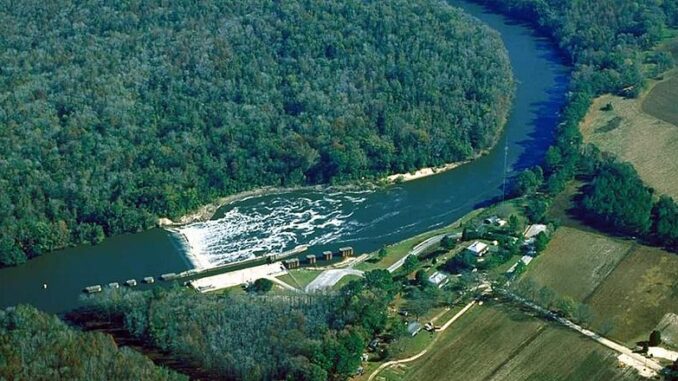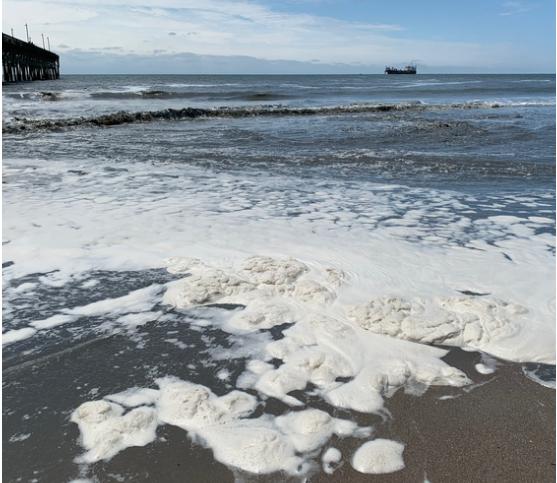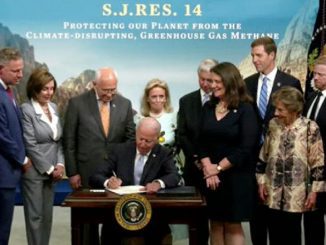
WASHINGTON, DC, April 24, 2024 (ENS) – The U.S. Environmental Protection Agency has issued the first national, legally enforceable drinking water standard to protect communities from exposure to harmful per-and polyfluoroalkyl substances, PFAS, often called forever chemicals.
Forever chemicals break down in the environment very slowly, and across the country, PFAS contamination is impacting the health and wellbeing of millions. People can be exposed to PFAS through drinking water or food contaminated with PFAS, by coming into contact with products that contain PFAS, or through workplace exposures in certain industries.
PFAS are a category of chemicals used since the 1940s to repel oil and water and resist heat. They are in everyday products such as nonstick cookware, stain resistant clothing, and firefighting foam, and they tend to migrate to groundwater.

The science is clear that exposure to certain PFAS over a long period of time can cause cancer, can impact the liver and heart, and cause immune and developmental damage to infants and children.
The final rule is expected to reduce PFAS exposure for approximately 100 million people, prevent thousands of deaths, and reduce tens of thousands of serious illnesses, the EPA says. It complements President Joe Biden’s government-wide action plan to combat PFAS pollution and is part of EPA’s PFAS Strategic Roadmap announced in October 2021.
“Drinking water contaminated with PFAS has plagued communities across this country for too long,” said EPA Administrator Michael Regan. “That is why President Biden has made tackling PFAS a top priority, investing historic resources to address these harmful chemicals and protect communities nationwide. Our PFAS Strategic Roadmap marshals the full breadth of EPA’s authority and resources to protect people from these harmful forever chemicals.
EPA is making nearly $1 billion in funding newly available through the Bipartisan Infrastructure Law to help states and territories implement PFAS testing and treatment at public water systems and to help owners of private wells address PFAS contamination.
Overall, through the Bipartisan Infrastructure Law, EPA is making an unprecedented $21 billion available to strengthen the U.S. drinking water systems, including by addressing PFAS contamination. Of that, $9 billion is specifically for tackling PFAS and emerging contaminants.
What Happened to the Cape Fear River
EPA Administrator Michael Regan joined White House Council on Environmental Quality Chair Brenda Mallory to announce the final standard April 10 at an event in Fayetteville, North Carolina, a city of 336,600, located next to a large U.S. Army base, Fort Bragg.
The Cape Fear River is the most industrialized river in North Carolina, lined with power plants, factories, wastewater treatment plants, landfills, paper mills, and industrial agriculture. The river is polluted by suspended solids and manmade chemicals, including PFAS byproducts of the production of the fluoropolymer Nafion. This Chemours product has attracted attention as a proton conductor for proton exchange membrane fuel cells because of its chemical and mechanical stability in the harsh conditions of this application.
In 2017, area residents learned that the Cape Fear River, the drinking water source for a million people in the region, had been contaminated with PFAS pollution from chemical giant Chemours’ PFAS manufacturing plant, the Fayetteville Works facility. The pollution reached more than 250 local drinking water wells in addition to the river.

A 2019 state consent order legally required Chemours to stop the pollution from its Fayetteville Works plant and reduce air emissions by at least 99 percent. Chemours invested $100 million on air emission controls that the company promoted as being capable of destroying PFAS, considered to be an impossible task on an industrial scale. Company and state agreed, the 99 percent standard had been reached.
But an investigation by the UK’s Guardian newspaper showed otherwise. “Using a more comprehensive test than those used by state regulators,” the Guardian reported that its investigators found “PFAS levels outside the plant far above those detected and reported as evidence of Chemours’ success – as much as 30 times higher.”
The researchers are concerned that the air emissions from the Fayetteville Works facility contribute to widespread PFAS contamination of the region’s water and food supplies.
Biden Administration officials are hopeful that the new EPA final rule limiting the concentrations of forever chemicals will clean up the water supply and help protect communities like Fayetteville from further devastating impacts of PFAS pollution.
“President Biden believes that everyone deserves access to clean, safe drinking water, and he is delivering on that promise,” Mallory said. “The first national drinking water standards for PFAS marks a significant step towards delivering on the Biden-Harris Administration’s commitment to advancing environmental justice, protecting communities, and securing clean water for people across the country.”
The new limits in the final rule are achievable using a range of available technologies and approaches, such as granular activated carbon, reverse osmosis, and ion exchange systems. Drinking water systems will have flexibility to determine the best solutions for their own communities.
For instance, the Cape Fear Public Utility Authority, serving Wilmington, North Carolina on the Atlantic coast – one of the communities most affected by PFAS contamination – has deployed a granular activated carbon system to remove PFAS regulated by this rule.
Emily Donovan, co-founder of the nonprofit Clean Cape Fear, said, “We learned about GenX and other PFAS in our tap water six years ago. I raised my children on this water and watched loved ones suffer from rare or recurrent cancers. No one should ever worry if their tap water will make them sick or give them cancer.”

“I’m grateful the Biden EPA heard our pleas and kept its promise to the American people. We will keep fighting until all exposures to PFAS end and the chemical companies responsible for business-related human rights abuses are held fully accountable,” Donovan declared.
There is much work to do before that happens. Chemours, a PFAS manufacturer spun off from DuPont in 2015, has contaminated the environment across hundreds of square miles in southeast North Carolina with PFAS waste, a previous Guardian analysis of regulatory documents found.
Additionally, this final rule advances President Biden’s commitment to ending cancer as we know it as part of the Biden Cancer Moonshot, to ensuring that all Americans have access to clean, safe, drinking water, and to furthering the Biden-Harris Administration’s commitment to environmental justice by protecting communities that are most exposed to toxic chemicals.
“Under President Biden’s leadership, we are taking a whole-of-government approach to tackle PFAS pollution and ensure that all Americans have access to clean, safe drinking water. Today’s announcement by EPA complements these efforts and will help keep our communities safe from these toxic ‘forever chemicals,'” said Deputy Assistant to the President for the Cancer Moonshot, Dr. Danielle Carnival.
EPA is establishing legally enforceable levels for several PFAS known to occur individually and as mixtures in drinking water.
This rule sets limits for five individual PFAS: PFOA, PFOS, PFNA, PFHxS, and HFPO-DA – sometimes called “GenX Chemicals.” GenX chemicals are used as replacements for PFOA in the manufacturing of fluoropolymers such as Teflon.
The rule also sets a limit for mixtures of any two or more of four PFAS: PFNA, PFHxS, PFBS, and “GenX chemicals.”
What Public Drinking Water Systems Will Have to Do
EPA estimates that between about six percent and 10 percent of the 66,000 public drinking water systems subject to this rule may have to take action to reduce PFAS to meet these new standards.
All public water systems have three years to complete their initial monitoring for these chemicals. They must inform the public of the level of PFAS measured in their drinking water. Where PFAS is found at levels that exceed these standards, systems must implement solutions to reduce PFAS in their drinking water within five years.
EPA will be working closely with state co-regulators in supporting water systems and local officials to implement this rule.
In the coming weeks, EPA will host a series of webinars to provide information to the public, communities, and water utilities about the final PFAS drinking water regulation.
To learn more about the webinars, please visit EPA’s PFAS drinking water regulation webpage.
EPA has also published a toolkit of communications resources to help drinking water systems and community leaders educate the public about PFAS, where they come from, their health risks, how to reduce exposure, and about this rule.
“We are thankful that Administrator Regan and the Biden Administration are taking this action to protect drinking water in North Carolina and across the country,” North Carolina Governor Roy Cooper said. “We asked for this because we know science-based standards for PFAS and other compounds are desperately needed.”
“For decades, the American people have been exposed to the family of incredibly toxic ‘forever chemicals’ known as PFAS with no protection from their government. Those chemicals now contaminate virtually all Americans from birth. That’s because for generations, PFAS chemicals slid off of every federal environmental law like a fried egg off a Teflon pan – until Joe Biden came along,” said Environmental Working Group President and Co-Founder Ken Cook.
“We commend EPA Administrator Michael Regan for his tireless leadership to make this decision a reality, and CEQ Chair Brenda Mallory for making sure PFAS is tackled with the ‘whole of government’ approach President Biden promised,” Cook said.
“There is much work yet to be done to end PFAS pollution,” he said. “The fact that the EPA has adopted the very strong policy announced today should give everyone confidence that the Biden Administration will stay the course and keep the President’s promises, until the American people are protected, at long last, from the scourge of PFAS pollution.”
Additionally, EPA has a nationwide Water Technical Assistance program to help small, rural, and disadvantaged communities access federal resources by working directly with water systems to identify challenges like PFAS; develop plans; build technical, managerial, and financial capacity; and apply for water infrastructure funding. Click here https://www.epa.gov/water-infrastructure/water-technical-assistance-programs to find out more about EPA’s Water Technical Assistance programs.
Featured image: One of three dams on the Cape Fear River. The waterway is polluted by industry, cities, and farmland in its drainage basin. (Photo courtesy North Carolina Health News)
© 2024, Environment News Service. All rights reserved. Content may be quoted only with proper attribution and a direct link to the original article. Full reproduction is prohibited.



